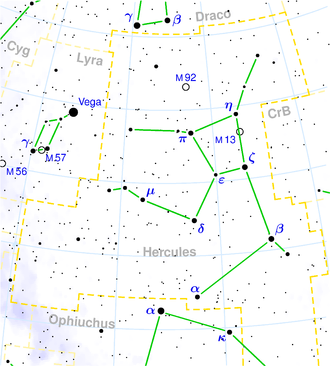NGC 6081
| Galaxy NGC 6081 |
|
|---|---|

|
|
| SDSS recording | |
| AladinLite | |
| Constellation | Hercules |
|
Position equinox : J2000.0 , epoch : J2000.0 |
|
| Right ascension | 16 h 12 m 56.8 s |
| declination | + 09 ° 52 ′ 02 ″ |
| Appearance | |
| Morphological type | S0 / LINER |
| Brightness (visual) | 13.5 likes |
| Brightness (B-band) | 14.5 mag |
| Angular expansion | 1.8 ′ × 0.6 ′ |
| Position angle | 131 ° |
| Surface brightness | 13.5 mag / arcmin² |
| Physical data | |
| Affiliation | isolated |
| Redshift | 0.017265 ± 0.000103 |
| Radial velocity | (5176 ± 31) km / s |
|
Stroke distance v rad / H 0 |
(235 ± 17) · 10 6 ly (72 ± 5.1) Mpc |
| history | |
| discovery | Édouard Stephan |
| Discovery date | July 26, 1870 |
| Catalog names | |
| NGC 6081 • IC 1202 • UGC 10272 • PGC 57506 • CGCG 079-078 • MCG + 02-41-19 • 2MASX J16125685 + 0952016 • GC 5808 • NVSS J161256 + 095201 • 2MIG 2213 | |
NGC 6081 = IC 1202 is a 13.5 mag bright lens-shaped galaxy with an active nucleus of the Hubble-type S0 in the constellation Hercules in the northern sky . It is estimated to be 235 million light years from the Milky Way and about 125,000 light years across . In the same area of the sky are u. a. the galaxies IC 1199 and IC 1205 .
The object was discovered on June 26, 1870 by Édouard Stephan . Lewis A. Swift's observation on April 7, 1888, with an identical description in the same position, was not recognized by Dreyer as a duplicate and led to an entry in the index catalog under IC 1202 .
Web links
- NGC 6081. SIMBAD , accessed May 29, 2016 .
- NGC 6081. DSO Browser, accessed May 29, 2016 .
- Auke Slotegraaf : NGC 6081. Deep Sky Observer's Companion, accessed on May 29, 2016 .
